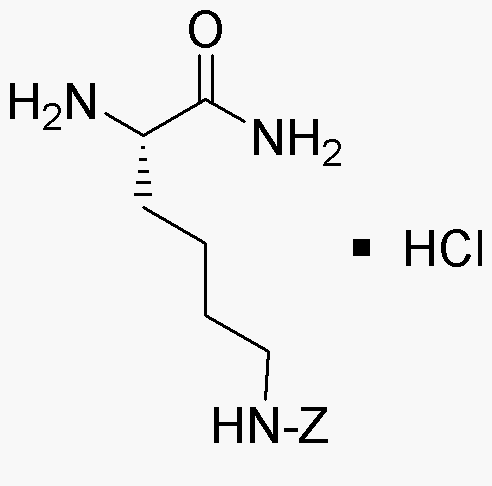Ne-Z-L-lysine amide hydrochloride is widely utilized in research focused on:
- Pharmaceutical Development: This compound serves as a key intermediate in synthesizing various pharmaceuticals, particularly those targeting metabolic disorders.
- Biotechnology: It is used in the formulation of peptide-based drugs, enhancing their stability and bioavailability, which is crucial for effective treatment.
- Cosmetic Industry: The compound is incorporated into skincare products for its moisturizing properties, helping to improve skin hydration and elasticity.
- Food Industry: It acts as a food additive, enhancing flavor and nutritional value in protein-rich foods, appealing to health-conscious consumers.
- Research Applications: In academic settings, it is employed in studies related to protein synthesis and enzyme activity, providing insights into biological processes.
General Information
Properties
Safety and Regulations
Applications
Ne-Z-L-lysine amide hydrochloride is widely utilized in research focused on:
- Pharmaceutical Development: This compound serves as a key intermediate in synthesizing various pharmaceuticals, particularly those targeting metabolic disorders.
- Biotechnology: It is used in the formulation of peptide-based drugs, enhancing their stability and bioavailability, which is crucial for effective treatment.
- Cosmetic Industry: The compound is incorporated into skincare products for its moisturizing properties, helping to improve skin hydration and elasticity.
- Food Industry: It acts as a food additive, enhancing flavor and nutritional value in protein-rich foods, appealing to health-conscious consumers.
- Research Applications: In academic settings, it is employed in studies related to protein synthesis and enzyme activity, providing insights into biological processes.
Documents
Safety Data Sheets (SDS)
The SDS provides comprehensive safety information on handling, storage, and disposal of the product.
Product Specification (PS)
The PS provides a comprehensive breakdown of the product’s properties, including chemical composition, physical state, purity, and storage requirements. It also details acceptable quality ranges and the product's intended applications.
Certificates of Analysis (COA)
Search for Certificates of Analysis (COA) by entering the products Lot Number. Lot and Batch Numbers can be found on a product’s label following the words ‘Lot’ or ‘Batch’.
*Catalog Number
*Lot Number
Certificates Of Origin (COO)
This COO confirms the country where the product was manufactured, and also details the materials and components used in it and whether it is derived from natural, synthetic, or other specific sources. This certificate may be required for customs, trade, and regulatory compliance.
*Catalog Number
*Lot Number
Safety Data Sheets (SDS)
The SDS provides comprehensive safety information on handling, storage, and disposal of the product.
DownloadProduct Specification (PS)
The PS provides a comprehensive breakdown of the product’s properties, including chemical composition, physical state, purity, and storage requirements. It also details acceptable quality ranges and the product's intended applications.
DownloadCertificates of Analysis (COA)
Search for Certificates of Analysis (COA) by entering the products Lot Number. Lot and Batch Numbers can be found on a product’s label following the words ‘Lot’ or ‘Batch’.
*Catalog Number
*Lot Number
Certificates Of Origin (COO)
This COO confirms the country where the product was manufactured, and also details the materials and components used in it and whether it is derived from natural, synthetic, or other specific sources. This certificate may be required for customs, trade, and regulatory compliance.


